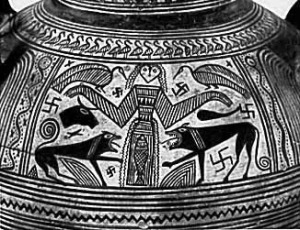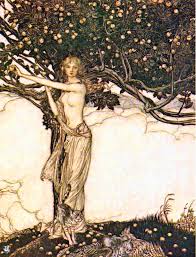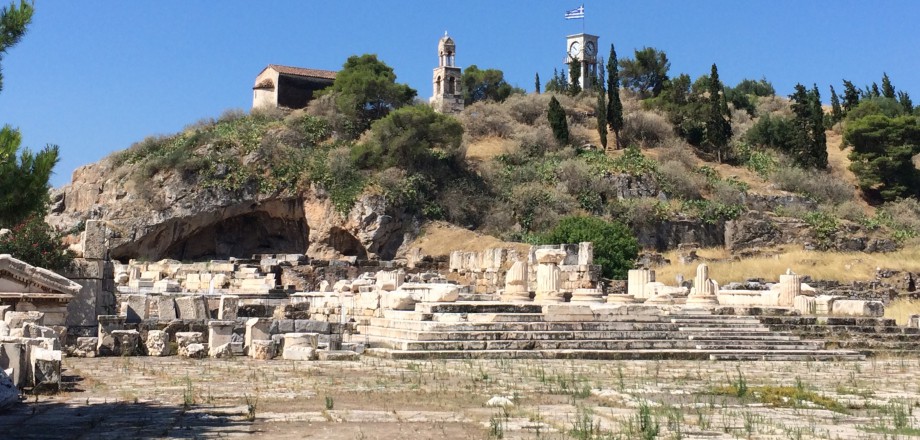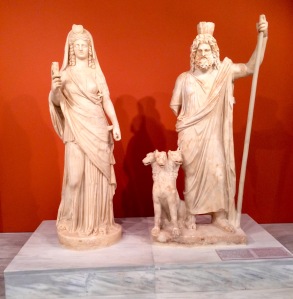
Bronze Age Minoan Pottery Showing Diktynna as Mistress of Wild Animals
I sing a song of ancient netting, nets to snare small game in the hunt, and fishing nets to trap small fry hard to catch with hook and line. These nets were such an advance, such an advantage in the age of stone weapons. Nets eased the effort needed to catch tender fish and animals, nets made it easier for humankind to eat more flesh. And so the humans prospered from using the nets, they grew, they evolved their gifts and talents, they gained in strength and wisdom, from these nets that made it easier for humankind to eat.
Were the first hunting and fishing nets made of nettle fibers? Perhaps hemp, or linen? We will never know, such materials degrade quickly. But we know that plant fiber nets, cordage, string, baskets, even fabrics, predate pottery. Extremely ancient pottery sometimes features incised lines imitating basketry, and some people believe pottery evolved from baskets lined with clay to carry water.
Deities of hunting, deities of agriculture, deities of craft, deities changing as human needs changed over the centuries and millennia. Tracing the family tree of a pantheon, watching how the divinities change through time, this says more about the humans of the day than any truths about the divinities. Of all the shifting and changing divinities in the ancient Greek pantheon, Artemis is one of the most mysterious. Her dominion over the Moon, Her love of the wild places and the hunt, Her twinship with Apollon, these important aspects of Her later Goddesshood seem only tangentially connected to the images of Artemis from Her wondrous shrine at Ephesus. She is a Goddess of all humanity by now, an ancient Goddess, and a very complicated Goddess. And here is a story about one of the older emanations of an Artemis-like Goddess, an ancient Cretan Goddess I feel sure is one of Artemis’ Own early roots, one of Her truly ancient aspects. Diktynna is this ancient Cretan Goddess’ name.
All divinities start out as spirits of place. The greatest lessons I learned in Greece was yet more about the interweaving relation between divinities Who have become universal deities of all humanity, and the places that gave rise to Their mythos. This is true in all religions that honor the Earth Mysteries. To understand the Gods more fully, visit Their places of origin, see where They had Their adventures, experience the landscape that gave rise to Their mysteries.
My dear friend the admired Gwendolyn visited Crete several years back, and made pilgrimage to the Psychro Cave, also known as Diktaion Antron, the Cave of Diktynna. And when Gwendolyn came home, she told me that she felt I should also make that pilgrimage, that I would receive help from a visit there, that I had work to do with the spirits in that cave. I take Gwendolyn’s advice very seriously, so to the Psychro Cave we went, on our first excursion in Crete. We thought we were going to visit the cave where Rhea gave birth to the infant Zeus, and so we were. But true myth is always multivalent, so our visit to the cave was far more complicated and subtle than that.
When I was packing to leave, I included a favorite stone, a jet I’ve had for many years, a solid palm stone with a subtle but natural shape, and a crevasse in the stone in which a red pebble is trapped. I love that stone. I impulsively packed it, hearing a voice that told me to bring it. And that morning, I was asked to offer that precious stone in the Psychro Cave. And I did so.
We climbed very far up Mount Dikte to the mouth of the cave, and then very far down to the bottom of the cave. Stalactites and stalagmites abounded. I am not entirely well, and it was a great effort for me. I was worried about slipping on the steep, wet steps into the cave, and I clung to the bannister for dear life. Happily there was an interruption in the otherwise steady flow of Russian and Eastern European visitors to the cave, long enough for us to have several private moments. We discussed exactly where lovely Rhea huddled to complete Her labor, and we had time to pray, asking the Old Ones to return to us at this time in history, praying that Their ancient rites may thrive, praying that the Old Gods’ divine natures and Their magnificent deeds will inspire worshipers once again. Then I offered the precious jet stone to the darkest, furthest recess of the cave.
I was strangely energized walking up the stairs out of the cave, much less tired than I would have thought. By the lips of the cave we found a few moments of complete privacy to offer the classic votives of olive oil, honey, Metaxa, and dried lavender flowers on an earthen spot. Again we had enough privacy to pray that the Ancient Ones be invigorated with our hymns of praise, that They rise once again to glory in our time, Their worship manifest in the world.
And later, I read about the history of the site. In the Heraklion Museum, we saw the finds dug from the cave, the many bronze votives, the many shards of pottery found by archaeologists. Amongst the locally made bronze votives was an exotic figure of Amon from Egypt, offered to the divinities in the cave, a place of worship and mystery from the new stone age onwards……or perhaps even earlier.
The cave is on Mount Dikte. And the plant associated with the worship practices at the cave is Dittany of Crete, an herb that aids in the evocation of spirits. Hmmm. Evocation of spirits. I have also asked Dittany for help in traveling through time. Dittany has been one of magical practitioners’ sacred herbs since earliest antiquity. It is Diktynna’s plant form, She is manifest in Dittany of Crete and Her herb’s fame is how She is chiefly remembered, other than giving Her sacred name to the very mountain holding the Diktaion Antron itself, Mount Dikte.
She is the Goddess of the Nets, the Sacred Huntress Who gave humanity the secret of making hunting and fishing nets. She said to me, “As One of the first, I dwindled when my children’s cults grew. They became my successors. Instead of being the mother of divinities of grain, I became Their daughter. Over the centuries and millennia, My nets became so normal that hunting and fishing nets seemed obvious to even the most simple of men.” And I suspect that this is why She has asked to sponsor me, because Diktynna expresses a large and important role in human history, and yet now She dwells in obscurity, for the most part subsumed in Britomartis.
Diktynna says She is the original form of the Goddess also known as Britomartis, that She, Diktynna, was the original and the root. The myths of the two Goddesses are confusing and bowdlerized. They join in the nets. Diktynna is described as a Nymph of the Forests around Mount Dikte. She is a frightening spirit Who wears a tusked, Gorgon-like face and runs through the forest as Mistress of the Animals. Appearing on Minoan seals, figures we believe depict Diktynna carry double-edged axes, hold writhing snakes, and have horned beasts rearing up on either side of Her. She wears a short hunting tunic. Her image has been found in a number of places on Crete outside Her home valley.
Britomartis came later, Diktynna says. In the beginning, Britomartis brought humanity fishing nets. Spenser put Britomartis in The Faerie Queen, because Britomartis “sought to preserve Her chastity from Minos” and that suited Spenser’s theme. Disentangling the glittering strands of ancient myths is always a challenge: scholars of all ages emphasize the parts of the myth most congruent with their mores, and with the spirits of their own age. Most readers disregard the multivalence of all true mythology. We in the modern Pagan movement are still learning this about the nature and character of the Gods: They are more various and subtle than our current popular paradigm reflects. Our current popular paradigm for understanding the multivalent Pagan deities of antiquity has taken shape in an environment of monolithic monotheism. The many aspects deities take is something most of us are still exploring.
In our age, too, when technology marches on, we take old tech for granted and the old tech’s revolutionary effects on our lives are forgotten. We do not remember or acknowledge the time before the invention of nets. It has been many millennia since all humanity shared this innovation. The nets—so revolutionary at one time that a Goddess was revered for revealing their use to humanity—have become ho-hum. Diktynna is sad for that. Deities do not like to be forgotten.
Diktynna helped Rhea give birth to Zeus in Her holy cave. Diktynna says Amalthea was Her own domesticated Goat, and that the wild goats caught in Her nets provided stock for the domesticated goats we know today. Thus, Diktynna helped humans develop dairying. Diktynna gave Amalthea’s milk to Zeus so that He would prosper and thrive.
Diktynna concealed the infant Zeus, and protected Him while His holy mother Rhea sneakily tricked Kronos into swallowing a swaddled stone in place of His latest offspring. Inside the devouring father, Hestia, Hera, Demeter, Hades, and Poseidon lay dreaming of Their age of power yet to come. Is this a mythic code for Zeus as a culture-bringer moving the ancients away from a practice of infant sacrifice?
Bards also say that Zeus was born on Mount Ida, people sing of Dodona’s oaks on the mainland, but most people agree that Zeus was born and raised on Crete. The legends about Zeus are as immortal as His being. His divine nature is rich with multiple functions, He enjoys countless aspects, and He received worship at a multitude of cult sites in antiquity. His temple at Olympia was one of the wonders of the ancient world. He contains such a multiplicity that it is not surprising that He had several births in different places. And that is a mythic truth right there, not easily understood by moderns raised on illusions of immutable truths written in a book standing where natural laws and colorful stories once reigned supreme.
So I offered to Diktynna first, when we got to Crete. On the very last day of our trip, we visited Aegina. I gave my heart to the pedimental sculpture of the Temple of Athena Aphaea at Aegina long since, when I was a student in Munich in 1978. I returned to the Glythothek Museum again and again to see the sculptures during my months in Bavaria. The pediments were stolen by British people and then sold to the Mad King Ludwig of Bavaria in the early 19th century. They are by far my favorite ancient pediment, and I was ecstatic to be able to visit their home temple on my trip.
Now Aegina is the Island of Pistachios, although they are native to Persia and were not grown on the island in antiquity. Our tour group stood munching on pistachio nuts in the shade outside the temple, listening to our amazing guide Tanya tell the story of the purely Doric building we saw. The temple sits on a promontory with a view of the sea, glowing like an antique jewel. It is a tiny sister temple of the Parthenon, in a very similar style. But the Doric temple was built on top of an earlier temple, dedicated to Aphaea, an indigenous Goddess that predated Athena’s worship at the site. Aphaea was the local aspect of Britomartis, said Tanya, worshiped only on Aegina, only on this very site where we stood. Aphaea was a Goddess of Fishing Nets. Her name also contains a meaning about Her mysterious disappearance, on the site of the temple, soon after She had arrived on the island. And then Tanya said that Britomartis was an aspect of Diktynna. This important information slipped by me like a bright eel in a quick-running river, and the importance of beginning and ending my trip with Diktynna was lost to me, in that moment.
Aphaea was consolidated under Athena’s greater Goddesshood due more to political expedience and geographical proximity than resonance. Diktynna, Britomartis, and Aphaea all resonate more closely to Artemis in my opinion. Artemis was a famous and dedicated Divine Midwife. Diktynna acted as midwife to Rhea during the birth of Zeus in the Psychro Cave. And Their mystery—the nets—is a mystery of the hunt, positing that fishing is a sea-borne hunt. The hunting and fishing nets are ancient tools, and so Their mystery places these three allied divinities firmly in the Stone Age, before the development of agriculture, in my opinion. The nets are estimated to be first used in the realm of 40 thousand years ago. Diktynna is a very very ancient divinity.
I am still pondering Diktynna’s association with Britomartis. Their various myths are complicated, and the myths have obviously changed over the centuries. I am still discovering different resonances among Their divine natures. One of the lovely things about Britomartis: Her name means Bright Maiden. It is described on wikipedia as an apotropaic euphemism, a phrase I’d not read before. But we are all familiar with dangerous deities being referred to in extra-polite terms. Perhaps if we humans are sufficiently polite to Them, They won’t hurt us. Calling the Furies—the Erinyes, ancient Greek Avenging Goddesses—the Eumenides, or the Kindly Ones, is merely wise on our parts.
Diktynna and Britomartis are so entwined that They often re-direct to One Another in computer searches, and Judika Illes has one article mentioning the two of Them, filed under Britomartis in The Encyclopedia of Spirits. Their myths and Their divine natures were explored by writers in antiquity like Aristophanes, Strabo, Pausanias, and even Apuleius, in his famous Golden Ass. There are Minoan seals thought to depict Diktynna, in the famous Mistress of Animals pose. Some people think the Cretan Snake Goddess statues represent Diktynna.
Just in case I overlooked the importance of the Dittany of Crete to my personal spiritual path, on our long, long flight home I watched the last two Harry Potter movies. Dittany was in the movie. Hermione calls for Harry to bring Essence of Dittany so she can heal Ron when he gets splinched. I was so surprised, I played the scene several times to make sure that I had not misheard. Dittany of Crete began my adventures in Greece and even accompanied me home in a movie. Humans are notoriously thick, so it’s nice to have so many signs and omens all pointing to the same conclusion.
I haven’t written about what happened in Delphi yet, but it was enormously important and life-changing. I was planning to take a new magical name to add to the two I am currently using. But Diktynna was the One coming to me all the whole trip, my alpha and omega Goddess on this pilgrimage, and it is Her holy name that I will be adding to my own. She has said that giving Her name to Mount Dikte is one way to tell that She is the most ancient of the three, Diktynna, Britomartis, and Aphaea.
And so I introduce myself to you all anew: my magical name is now Hazel Pomona Diktynna.
Hail to You, dear Goddess! dear Midwife of Rhea, Foster Mother of Infant Zeus! Hail, Diktynna of the Nets, Diktynna of the Diktaion Antron on Mount Dikte. Hail, Blessed Goddess of the Holy Hunting Net.
And Hail also to Zeus Diktaios! Zeus Diktiaos has been a local epithet of Zeus on Crete since Mycenaean times, pertaining to the Dikte mountain range….and presumably, to His birth in the Diktaion Antron, now called the Psychro Cave.
There is so much more. I feel like my head is exploding. A lot of it is about restoring Goddesses to Their rightful places. It’s making me really happy that this is a major concern to Zeus, Who has been grossly misunderstood in my opinion. Gwendolyn told me something very interesting: in ancient Greek, there is no word that means rape. A lot of what we have been told was colored by the mores of the Victorian translators of ancient texts. Their Victorian attitudes sometimes became distressingly codified into the ancient myths, distorting the old stories in confusing ways. I have a great deal more to write about this, including musings on the boundary between the Bronze and Iron Ages, and their differing methods of calculating descent—and how that has altered our understanding of the old stories. There is a whole article on Herakles, again, responding to Gwendolyn’s statement that His club indicates a Stone Age origin for His mythos…..and that one includes a disambiguation of Hera’s role in Herakles’ myth cycle. Stay tuned if these thoughts intrigue you.
I hope you’ve enjoyed meeting Diktynna as the first installment of these Greek musings. I think Diktynna is completely amazing and utterly fascinating, personally.
Love and blessings from Caroline



